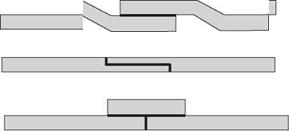A fillet of adhesive is almost invariably formed outside the joint (Figure 5.7) and this can be beneficial in that it reduces the stress concentrations at the end of the joint. For this reason the excess adhesive should only be removed for aesthetic purposes.
The lap shear joint has been the subject of much academic study, particularly with metal substrates but due to the wide variety of plastics available there seems to be little published data when it comes to bonding plastics.
In some plastic engineering applications the load on the joint is very low, perhaps only the weight of the bonded parts, and so it will not be necessary to pay too much attention to joint design and the shape most easily fabricated can be selected. For higher load joints the joint design will require more careful consideration and testing prior to manufacture.
A few simple suggestions for improving the stress distribution across a lap shear joint are shown in Figure 5.8 but the application and manufacturing process will define the options available.
 |
Rigid adhesives (e. g., standard ethyl cyanoacrylates) are used for bonding assemblies when the joints can be designed to be subjected only to shear and normal static forces. If the application is subjected to peel stresses or impact loads, a toughened adhesive (e. g., epoxy, two-part acrylic or toughened cyanoacrylate) would be more suitable.
 29 октября, 2015
29 октября, 2015  Pokraskin
Pokraskin  Опубликовано в рубрике
Опубликовано в рубрике 